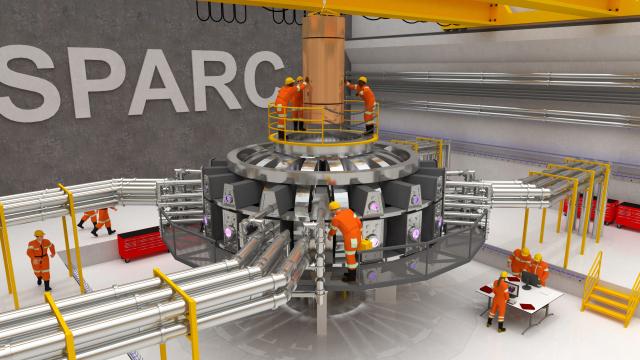Nuclear fusion is like a way-more-efficient version of solar power – except instead of harnessing energy from the rays of a distant sun, scientists create miniature suns in power plants here on Earth. It would be vastly more efficient, and more importantly, much cleaner, than current methods of energy production. The main issue is that actually realising fusion power has been really difficult.
What the power plant, “Sparc”, could look like. Graphic: Christine Daniloff (MIT)
But MIT has announced yesterday that it is working with a new private company called Commonwealth Fusion Systems (CFS) to make nuclear fusion finally happen. CFS recently attracted a $US50 million ($64 million) investment from the Italian energy company Eni, which it will use to fund the development.
The goal? “The 15-year timeline is to get a device that puts 200 megawatts on the grid,” CFS CEO and MIT grad Robert Mumgaard told Gizmodo. “That’s a small city.”
Nuclear fusion is the process by which two hydrogen atoms are fused together into helium. This process results in the release of a lot of energy. Scientists have been chasing fusion for a long time, perhaps since the 1950s. But there have been technological roadblocks, mainly making a device that outputs more energy than it takes to run. Another fusion device under construction in Europe called ITER, for example, should be ready by 2035 but is far over budget. The US Senate has attempted to pull out of the project, reports Nature.
MIT’s “tokamak” fusion reactor seems to promise much cheaper fusion power. It relies on a non-traditional, higher-temperature superconductor called ytterbium-barium-copper-oxide, a kind of cuprate, to allow electricity to flow efficiently without resistance. These produce strong magnetic fields and high pressures in plasma that confine the fusion reactions inside of the device. The sun confines its own reactions with its immense gravity.
The MIT group has been researching the device for a few years. This infusion of capital should allow them to build magnets four times stronger in the next three years. The planned device, called Sparc, will be a 65th of ITER’s size but release a fifth of the power, according to an email sent by MIT’s press office.
Of course, there are challenges. Martin Greenwald, deputy director of MIT’s Plasma Science and Fusion Center, told Gizmodo that they have yet to actually develop these magnets and integrate them into such a machine. They will also need to learn how to build and operate the device, and bring it to a position that it can actually enter the market.
It’s important to note that fusion is way different from fission, the process that powers current nuclear power plants. Fusion can’t cause an explosive runaway chain reaction without some sort of fissile material, and rather than using uranium like fission does, it’s water and lithium in, helium out. This also cuts down on nuclear weapons risks. “There’s no reason to have fissile materials around fusion plants,” said Greenwald. “If you do, you’re up to no good.”
Some, such as the folks at the Bulletin of the Atomic Scientists, still worry that the excess neutrons produced in fusion could lead to radioactive waste or contaminants, as well as high costs.
Nature points out that there are plenty others are in the fusion-with-high-temperature-superconductors game, too. Princeton has its own tokamak, and there’s a British company called Tokamak Energy using a similar device to produce fusion energy. But all of the cash towards the MIT effort is significant.
“If MIT can do what they are saying – and I have no reason to think that they can’t – this is a major step forward,” Stephen Dean, head of Fusion Power Associates, in Maryland, told Nature.
Perhaps all fusion power needed to become reality was, well, a lot of money. Mumgaard said that CFS’ collaboration with MIT will “provide the speed to take what’s happening in the lab and bring it to the market”.
[MIT, Nature]
